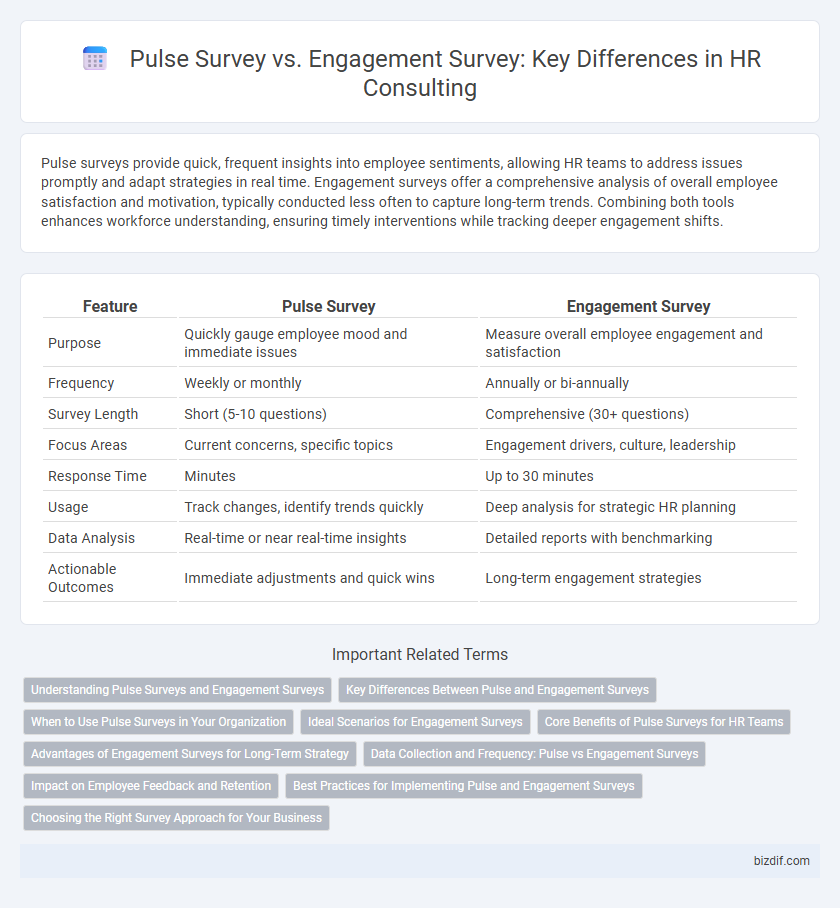Pulse surveys provide quick, frequent insights into employee sentiments, allowing HR teams to address issues promptly and adapt strategies in real time. Engagement surveys offer a comprehensive analysis of overall employee satisfaction and motivation, typically conducted less often to capture long-term trends. Combining both tools enhances workforce understanding, ensuring timely interventions while tracking deeper engagement shifts.
Table of Comparison
| Feature | Pulse Survey | Engagement Survey |
|---|---|---|
| Purpose | Quickly gauge employee mood and immediate issues | Measure overall employee engagement and satisfaction |
| Frequency | Weekly or monthly | Annually or bi-annually |
| Survey Length | Short (5-10 questions) | Comprehensive (30+ questions) |
| Focus Areas | Current concerns, specific topics | Engagement drivers, culture, leadership |
| Response Time | Minutes | Up to 30 minutes |
| Usage | Track changes, identify trends quickly | Deep analysis for strategic HR planning |
| Data Analysis | Real-time or near real-time insights | Detailed reports with benchmarking |
| Actionable Outcomes | Immediate adjustments and quick wins | Long-term engagement strategies |
Understanding Pulse Surveys and Engagement Surveys
Pulse surveys gather real-time employee feedback frequently, allowing HR professionals to quickly identify workplace issues and track changes in employee sentiment over short periods. Engagement surveys provide comprehensive insights into overall employee commitment, motivation, and satisfaction, typically conducted annually to inform long-term HR strategies. Both tools are essential for measuring employee experience but serve different purposes: pulse surveys enable agile responses, while engagement surveys support strategic planning.
Key Differences Between Pulse and Engagement Surveys
Pulse surveys are short, frequent assessments designed to capture real-time employee feedback on specific topics, enabling organizations to address issues promptly. Engagement surveys are comprehensive evaluations conducted less frequently, measuring overall employee satisfaction, commitment, and alignment with company values. Pulse surveys provide agility in monitoring workplace climate, while engagement surveys offer in-depth insights into long-term employee experience and organizational culture.
When to Use Pulse Surveys in Your Organization
Pulse surveys are ideal for capturing real-time employee feedback during periods of rapid change or after implementing new policies, allowing organizations to quickly identify and address emerging issues. These short, frequent surveys enhance agility by monitoring employee sentiment continuously, helping HR teams fine-tune engagement strategies effectively. Pulse surveys complement broader engagement surveys by providing targeted insights between comprehensive evaluations, ensuring timely and responsive workforce management.
Ideal Scenarios for Engagement Surveys
Engagement surveys are ideal for organizations seeking comprehensive insights into employee motivation, commitment, and overall workplace culture to drive long-term strategic improvements. They work best when conducted periodically to measure trends over time and inform leadership decisions on talent management, retention, and organizational development. Engagement surveys typically provide a broader scope of data compared to pulse surveys, enabling a deeper understanding of employee experiences and systemic issues.
Core Benefits of Pulse Surveys for HR Teams
Pulse surveys provide HR teams with real-time insights into employee sentiment, enabling swift identification of workplace issues and fostering proactive engagement strategies. These short, frequent surveys increase response rates by minimizing survey fatigue and delivering timely feedback that informs agile HR interventions. Leveraging pulse surveys enhances strategic decision-making, supports continuous improvement in employee experience, and drives higher organizational productivity.
Advantages of Engagement Surveys for Long-Term Strategy
Engagement surveys provide comprehensive insights into employee motivation, satisfaction, and organizational culture, enabling HR leaders to develop targeted long-term strategies for workforce development. These surveys help identify deep-rooted issues and track progress over time, fostering sustained improvements in employee retention and productivity. Unlike pulse surveys, engagement surveys offer a holistic view that supports strategic planning and aligns employee experience with business goals.
Data Collection and Frequency: Pulse vs Engagement Surveys
Pulse surveys collect targeted employee feedback frequently, often weekly or monthly, enabling real-time insights into workplace sentiment and swift identification of emerging issues. Engagement surveys, conducted less frequently--typically annually or biannually--gather comprehensive data on overall employee satisfaction, motivation, and commitment, providing a broad understanding of organizational health. The distinct data collection approaches impact decision-making speed, with pulse surveys supporting agile HR interventions and engagement surveys informing long-term strategic planning.
Impact on Employee Feedback and Retention
Pulse surveys deliver real-time, frequent insights that enable HR teams to quickly identify and address employee concerns, enhancing communication and boosting retention rates. Engagement surveys provide comprehensive data on long-term employee satisfaction and organizational culture, informing strategic HR initiatives that foster deeper commitment and reduce turnover. Together, these survey methods create a dynamic feedback loop that drives continuous improvement in employee experience and retention efforts.
Best Practices for Implementing Pulse and Engagement Surveys
Pulse surveys should be conducted frequently with concise, targeted questions to capture real-time employee sentiment and drive swift action. Engagement surveys require broader scope and depth, typically administered annually, to assess overall employee motivation and workplace culture. Best practices include ensuring anonymity, providing clear communication on purpose, and acting promptly on survey feedback to foster trust and improve organizational performance.
Choosing the Right Survey Approach for Your Business
Pulse surveys provide frequent, concise insights into employee sentiment, enabling real-time adjustments in the workplace. Engagement surveys deliver comprehensive data on overall employee motivation, culture, and satisfaction, guiding long-term strategic initiatives. Selecting the right survey depends on your business goals: pulse surveys suit agile feedback needs, while engagement surveys are ideal for in-depth analysis of workforce engagement trends.
pulse survey vs engagement survey Infographic

 bizdif.com
bizdif.com